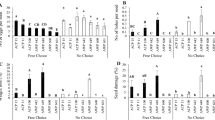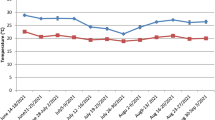Abstract
The susceptibility of eighty five green gram accessions were evaluated against pulse beetle, Callosobruchus analis (F.) under laboratory conditions. Accessions which exhibited lesser susceptibility index during the preliminary free choice tests were further subjected to ‘force choice’ test for confirmation of bruchid resistance. No green gram accession was found immune to bruchid infestation and showed significant difference in terms of oviposition, developmental period, adult emergence and seed weight loss. Two accessions viz, Km-12-5 and P-S-16 revealed lesser per cent adult emergence of 12.22 and 14.29, respectively. Prolonged developmental period (25.67 and 26.00 days, respectively) and lesser susceptibility index (0.042 and 0.044 respectively) in comparison to highly susceptible Ganga 8, which exhibited a survival of 71.67 %, developmental period of 20.67 days and susceptibility index of 0.09. Correlation between GI and other growth parameters of pulse beetle on different accessions indicated that GI had negative relationship with mean developmental period (−0.924) and significant positive relationship with adult emergence (0.931), weigh loss (0.952) and eggs laid (0.734). Hence, these accessions can be effectively used as promising donors for developing bruchid resistant varieties which would ensure food security by reducing postharvest losses under storage conditions.


Similar content being viewed by others
References
Khalil IA, Jan A (2002) Textbook of cropping technology. National Book Found, Pakistan
Tata Strategic Management Group—Why India needs to grow more pulses?. http://www.growmorepulses.com. Accessed 3 April 2012
Economic survey (2011–2012) Ministry of Finance, Department of Economic affairs. Government of India, pp 357–359
Chandrasekhar CP, Ghosh J (2002) Food economy in disarray. Indian Food Ind 21:10–14
Indiastat.com. Socio economic statistical information about india. http://www.indiastat.com/agriculture/2/pulses/17213/moong/19571/stats.aspx. Accessed 10 Jan 2015
CABI (2007) Crop protection compendium. CAB International, Wallingford
Prabhakar GS (1979) Studies on the bruchid fauna, infesting pulse crops of Karnataka with special emphasis on bioecology of Callosobruchus chinensis (L.). M. Sc. (Agri.), Dessertation, University of Agricultural Sciences, Bangalore
Shafique M, Ahmad M (2002) Screening of pulse grains for resistance to Callosobruchus analis (F.) (Coleoptera: Bruchidae). Pakistan. J Zool 34(4):293–296
Duraimurugan P, Raja K, Ragupathy A (2011) An ecofriently approach for management of pulse beetle, Callosobruchus maculatus through neem formulations assisted with pitfall trap. J Food Legumes 24:23–27
Southgate BJ (1979) Biology of the Bruchidae. Annu Rev Entomol 24:449–473
Talekar NS (1988) Biology, damage and control of bruchid pests of mungbean. In: Shanmugasundaram S, McLean BT (eds) Mungbean: proceeding of the second international symposium. Asian Vegetable Research and Development Center, Tainan, pp 329–342
Sharma OP, Bambawale OM, Gopali JB, Bhagat S, Yelshetty S, Singh SK, Anand R, Singh OP (2011) Field guide, mung bean and urd bean. National Centre for Integrated Pest Management, New Delhi, p 40
Singh SR, Jackai L (1985) Insect pest of cowpea in Africa: their life cycle, economic importance and potential for control. In: Singh SR, Rachiek O (eds) Cowpea research, production and utilization. Wiley, New York, pp 217–231
Singh A, Khare A, Singh AP (2012) Use of vegetable oils as biopesticide in grain protection—a review. J Biofertil Biopestic 3:114
Golob P (1997) Current status and future perspectives for inert dusts for control of stored product insects. J Stored Prod Res 33:69–79
Proctor DL (1994) Grain storage techniques: evolution and trends in developing countries. Food and Agricultural Organisation of the United Nations (FAO). Rome, Agricultural Services Bulletin No. 109
Howe RW (1971) A parameter for expressing the suitability of environment for insect development. J Stored Prod Res 7:63–65
Sulehrie MAQ, Golob P, Tran BMD, Farrell G (2003) The effect of attributes of Vigna spp. on the bionomics of Callosobruchus maculatus. Entomol Exp Appl 106:159–168
Gibson KE, Raina AK (1972) A simple laboratory method of determining the seed host preference of bruchidae. J Econ Entomol 65:1189–1190
SAS (Statistical Analysis System) (1990) SAS/STAT user’s guide, version 6. SAS Institute, Cary
Badii KB, Asante SK, Sowley ENK (2013) Varietal susceptibility of cowpea (Vigna Unguiculata L.) to the storage beetle, Callosobruchus Maculatus F. (Coleoptera: Bruchidae). Int J Sci Technol Res 2(4):82–89
Giga D (1995) Selection of oviposition sites by cowpea weevils Callosobruchus rhodesianus (Pic.) and Callosobruchus maculatus (F.). Insect Sci Appl 16:145–149
Sarwar M (2012) Assessment of resistance to the attack of bean beetle Callosobruchus maculatus (Fabricius) in chickpea genotypes on the basis of various parameters during storage. Songklanakarin J Sci Technol 34(3):287–291
Dick KM, Credland PF (1984) Egg production and development of three strains of Callosobruchus maculatus (F.) (Coleoptera: Bruchidae). J Stored Prod Res 20:221–227
Wang M, Horng S (2004) Egg dumping and life history strategy of Callosobruchus maculatus. Physiol Entomol 29:26–31
Singh BB, Singh SR, Adjadi O (1985) Bruchid resistance in cowpea. Crop Sci 25(5):736–739
Shafique M, Ahmad M (2005) Chickpea grains resistance to pulse beetle, Callosobruchus analis (F.) (Coleoptera: Bruchidae). Pakistan. J Zool 37(2):123–126
Dongre TK, Pawar SE, Thakare RG, Harwalkar MR (1996) Identification of resistant sources to cowpea weevil (Callosobruchus maculatus (F.)) in Vigna sp. and inheritance of their resistance in black gram (Vigna mungo var. mungo). J Stored Prod Res 32:201–204
Somta P, Talekar NS, Srinives P (2006) Characterization of Callosobruchus chinensis (L.) resistance in Vigna umbellate (Thub.) Ohwi and Ohashi. J Stored Prod Res 42:313–327
Lambrides CJ, Imrie BC (2000) Susceptibility of mungbean varieties to the bruchid species Callosobruchus maculatus (F.), C. analis (Gyll.), C. chinenis (L.) and canthoscelides obtectus (Say.) (Coleoptera: Chrysomelidae). Aust J Agric Res 51:85–89
Chakraborty S, Chaudhuri N, Senapati SK (2004) Correlation between seed parameters and relative susceptibility of mungbean (Vigna radiata L.) genotypes to Callosobruchus chinensis L. during storage. Ann Plant Prot Sci 1:48–50
Jha AN, Srivastava C, Chandra N (2011) Screening of green gram (Vigna radiata) cultivars to three species of pulse beetle (Callosobruchus sp.). Indian J Agric Sci 81(3):283–286
Duraimurugan P, Pratap A, Singh SK, Gupta S (2014) Evaluation of screening methods for bruchid beetle (Callosobruchus chinensis) resistance in green gram (Vigna radiata) and blackgram (Vigna mungo) genotypes and influence of seed physical characteristics on its infestation. Vegetos 27(1):60–67
Redden RJ, McGuire J (1983) The genetic evaluation of bruchid resistance in seeds of cowpea. Aust J Agric Res 34:707–715
Jackai LEN, Asante SK (2003) A case for the standardization of protocols used in screening cowpea, Vigna unguiculata for resistance to Callosobruchus maculatus F. (Coleoptera: Bruchidae). J Stored Prod Res 39:251–263
Simmonds MSJ, Blaney WM, Birch ANE (1989) Legume seeds: the defences of wild and cultivated species of Phaseolus against attack by bruchid beetles. Ann Bot 63:177–184
Shade RE, Kitch LW, Mentzer P, Murdock LL (1996) Selection of a cowpea weevil (Coleptera: Bruchidae) biotype virulent to cowpea weevil resistant landrace TVu 2027. J Econ Entomol 89:1325–1331
Jensen DH (1977) How southern cowpea weevil larvae (Bruchidae Callosobruchus maculatus) die on non-host Seeds. Ecology 58:921–927
Deshpande SS (1992) Food legumes in human nutrition: A personal perspective. Crit Rev Food Sci 32:333–363
Savelkoul FHMG, Van Der Poel AFB, Tamminga S (1992) The presence and Inactivation of trypsin inhibitors, tannins, lectins and amylase inhibitors in legume seeds during germination. A review. Plant Food Hum Nutr 42:71–85
Osborn TC, Blake T, Gepts P, Bliss FA (1986) Bean arcelin. 2. Genetic variation, inheritance and linkage relationships of a novel seed protein of Phaseolus vulgaris L. Theor Appl Genet 71:847–855
Gatehouse AMR (1990) Biochemical bases of seed resistance to Zabrotes subfasciatus (Bean weevil) in Phaseolus vulgaris (common bean): a mechanism for arcelin toxicity. J Insect Physiol 36:757–767
Acknowledgments
The authors are thankful to Head, Division of Entomology, IARI, New Delhi for providing necessary facilities and Rajiv Ghandhi National Fellowship for financial support for conducting this work. The help and suggestions received from Dr. S. Subramanian, Principal Scientist, Division of Entomology, ICAR-IARI are duly acknowledged.
Author information
Authors and Affiliations
Corresponding author
Rights and permissions
About this article
Cite this article
Soumia, P.S., Srivastava, C., Dikshit, H.K. et al. Screening for Resistance Against Pulse Beetle, Callosobruchus analis (F.) in Greengram (Vigna radiata (L.) Wilczek) Accessions. Proc. Natl. Acad. Sci., India, Sect. B Biol. Sci. 87, 551–558 (2017). https://doi.org/10.1007/s40011-015-0635-5
Received:
Revised:
Accepted:
Published:
Issue Date:
DOI: https://doi.org/10.1007/s40011-015-0635-5




